-
Paper Information
- Next Paper
- Paper Submission
-
Journal Information
- About This Journal
- Editorial Board
- Current Issue
- Archive
- Author Guidelines
- Contact Us
International Journal of Networks and Communications
p-ISSN: 2168-4936 e-ISSN: 2168-4944
2013; 3(3): 81-90
doi:10.5923/j.ijnc.20130303.02
A Discriminatory Model of Self and Nonself Network Traffic
Adetunmbi A. O, Olubadeji Bukky, Alese B. K, Adeola O. S
Department of Computer Science, Federal University of Technology, Akure, Nigeria
Correspondence to: Adeola O. S, Department of Computer Science, Federal University of Technology, Akure, Nigeria.
| Email: |  |
Copyright © 2012 Scientific & Academic Publishing. All Rights Reserved.
The matrix of business and other transaction systems over the Internet makes computer security a critical issue in our day-to-day activities. In recent times, various approaches ranging from rule-based, expert system to data mining have been subjected to extensive research in handling security breaches on computer networks. Immune system (IS) presents a protection against the possibility of malfunctioning and failure of individual host cells. In mammals it keeps the organisms free of pathogens which are unfriendly foreign organisms, cells, or molecules. Two approaches to change detection which are based on the generation of T-cells were examined. One is an existing model while the other model is proposed by us, the one proposed by us is called immunological model, which is a protection model capable of autonomously detecting (Nonself) and opposing the attempts at intrusion and exploitation. The two models were implemented using C++ programming language and their feasibility determined on 1999 International Knowledge Discovery Intrusion Detection Datasets. The results reveal that our proposed model outperforms the existing model not only in terms of detection accuracy but also in terms of simplicity and generation of explainable rules inform of if ... then statements. The classification accuracy of our model christened IMSNT on training and test Datasets are 97.06% and 86.39% as against 89.65% and 85.70% on the Stephanie et al approach, which shows that it is a promising approach. The proposed system apart from its capability of detecting and monitoring the activities on the network can be used in extracting virus signature patterns.
Keywords: Immune System, T-cells, Intrusion Detection, Self-Network and Non-self Network
Cite this paper: Adetunmbi A. O, Olubadeji Bukky, Alese B. K, Adeola O. S, A Discriminatory Model of Self and Nonself Network Traffic, International Journal of Networks and Communications, Vol. 3 No. 3, 2013, pp. 81-90. doi: 10.5923/j.ijnc.20130303.02.
Article Outline
1. Introduction
- The Immune System (IS) is complex, and it has novel solutions for solving real-world problems. This can be applied as a solution to systems design in case there is an artificial system facing similar problems faced by the Immune System, which required reasonable understanding of immunology. The problem that the IS address is similar to the problem faced by computer security systems: the immune system protects the body from pathogens, and analogously, a computer security system should protect computers from intrusions. This analogy can be made more concrete by understanding the problems faced by computer security systems[1-2].The word immunity (from Latin immunitas) means "freedom from". The main purpose of the immune system is to keep the organism free from unfriendly foreign organisms, cells, or molecules (collectively called pathogens). The innate immune system primarily is inborn which consists of the endocytic and phagocytic systems, which involve motile scavenger cells such as macrophages that ingest extra cellular molecules and materials, clearing the system of both debris and pathogens. Most of the inspiration for this research has been drawn from the adaptive immune system (IS), and as such we shall preview an adaptive immunity.The adaptive immune system is so-called because it adapts or “learns” to recognize specific kinds of pathogens, and retains a “memory” of them for speeding up future responses. The learning occurs during a primary response to a kind of pathogen not encountered before by the Immune System. The primary response is slow, often first only becoming apparent ninety-six hours after the initial infection, and taking up to three weeks to clear the infection. After the primary response clears the infection, the IS retains a memory of the kind of pathogen that caused the infection. Should the body be infected again by the same kind of pathogen, the IS does not have to re-learn to recognize the pathogens, because it “remembers” their specific appearance, and so can mount a much more rapid and efficient secondary response.[3]. The secondary response is usually quick enough so that there are no clinical indications of a re-infection. Immune memory can confer protection up to the life-time of the organism (a canonical example is measles).Also a model of intrusion detection is based on the principles of the immune system, that carry out both signature-based and anomaly detection which has mechanisms for detecting deviations from a set of normal patterns, and it has ways of storing and recalling specific patterns associated with previous pathogenic attacks. Though, the current Computer security system protects computers from intrusions but the growing scale of computer networks and sophisticated software codes make them more vulnerable to alien intrusions, such as computer viruses, intentional corruption, among others that could lead to serious failures of computer-based information and control systems. Majority of the computer security systems widely used are either rule-based or expert system based which are characterized by low accuracy in terms of detections of intrusions on computer system or network. Various researchers have imbibed the concept of biological systems to resolve some facet of information security in a computer system and networking environment. Among these researchers include the works of[4] on Artificial Immune System for virus detection, and[5] on Artificial Immunity System for Network Security Situation Awareness Technology. Their findings show that it is a proving approach as it reduces false positive rate and cases of security incidence on computers and computer networks. The essence of the immune system is to keep the organisms free of pathogens which are unfriendly foreign organisms, cells, or molecules for survivability.The adaptive immune system made up of lymphocytes, with the ability to learn, recognize specific kinds of pathogens, and retains memory of them for future responses. The immune system model used is based on T-cells approach. Here, intrusive traffics refer to as nonself stand for pathogens while the classification model developed with the ability to learn and generate patterns of intrusions represent the T-cells. In this paper, an attempt is made to develop an immunological model to differentiate benign and malicious network traffic, demonstrating the feasibilities of these approaches on the experiment performed on intrusion detection data available at Massachusetts Institute of Technology, University website, USA.
2. Biological versus Computer Immune Systems
- There are different ways to interpret biological immune systems for security. The immune system is perhaps the most obvious system, which would have an analogy for security. Its role is to defend against attack, patch and clean up after an attack; thus appropriate for all of the threats.[6] reports antigens (foreign proteins) are recognized by antibodies (immune system detectors). The antibodies are highly specific, only binding to a small set of antigens if they do bind, then a complex set of events occur that result in the foreign protein being destroyed. Antibody cells are covered with antigen detectors and they are as theoretically likely to match and destroy healthy cells as foreign proteins. This would obviously be undesirable, and in most cases does not happen. The immune system thus appears to be able to discriminate between “self and “non-self”.[7] makes the analogy between self in the body and normal behaviour of a computer system (non-self is thus abnormal behaviour). Self is represented as a set of strings (with a variety of different representations) depending on the domain and antibodies or detectors are also represented as strings. The binding between the strings is modeled by a matching function, the most common one being contiguous bits, which returns true when two strings match in more than specified contiguous positions. This allows detectors to match a variety of strings.[7-8] use detectors for non-self (which is directly analogous to immune system), while in[9] uses detectors for self.
3. Review of Related Literatures
- It is well known that there are vulnerabilities in computer and network systems due to design flaws that can lead to security hazards[10, 11, and 19]. These flaws are expensive to fix and it is difficult or nearly impossible to build a completely secure system void of design and programming errors[12];[11] and[13]. Even a truly secure system is vulnerable to abuse by insiders who abuse their privileges[14].It is glaring that we are stuck with systems that have vulnerabilities for a while to come, the next direction is to employ intrusion detection as a last line of defense. The benefits of an intrusion detection system (IDS) include: Detecting attacks or break-ins on system as soon as possible preferably in real-time for appropriate actions: such as., shut down the connections, trace back to identify the intruders, or gather legal evidence to prosecute the intruder and prevention of similar attacks in the future.Intrusion detection is a process of detecting security breaches by examining user and program activities in a computer system. The most popular way to detect intrusions has been by using the audit data generated by the operating system. An adult trail is a record of activities on a system that are logged to a file in chronologically suited order. Since almost all activities are logged on a system, it is possible that a manual inspection of these logs would allow intrusions to be detected. However, the incredibly large sizes of audit data generated make manual analysis impossible. IDS automate the drudgery of wading through the audit jungle. Audit trails are particularly useful because they can be used to establish guilt of attackers, and they are often the only way to detect unauthorized but subversive user activity. The main goal of effective IDS is to provide high rates of attack detection with very small rates of false alarms[15]. Here, IDS is simply categorized along two dimensions: Intrusion detection approach – Misuse or anomaly detection and protected system – host or network based.
4. Intrusion Detection Datasets
- The development of intrusion detection system has been hampered due to lack of a common metric to gauge the performance of current systems. Evaluation has really helped to solve this problem in other developing technologies and have guided research by identifying the strengths and weaknesses of alternate approaches. Ideally IDS should be evaluated on a real network and tested with real attacks. However, it is difficult to repeat such test so that other researchers can replicate the evaluation. In doing this, network traffic would have to be captured and reused. This raises the issue of privacy because sensitive information such as email messages and passwords can be contained in real traffic[16].The KDD Cup 1999[17] used for benchmarking intrusion detection problems is used in our experiment. The dataset was a collection of simulated raw TCP dump data over a period of nine weeks on a local area network. The training data was processed to about five million connection records from seven weeks of network traffic and two weeks of testing data yielded around two million connection records. The training data is made up of 22 different attacks out of the 39 present in the test data. The attacks types are grouped into four categories: DOS, Probe, R2L and U2R, since our focus is not to detect each attack type but the major category into which each falls. Table 1 gives the different attack types contained in the datasets.
|
5. The Immunological Model
- The model environment is defined over a universal set U, where U is a finite set of finite patterns and is partitioned into two sets, S and N, called self and nonself, respectively, such that S∪N = U and S∩N =Ø. Self patterns represent acceptable or legitimate events, and nonself patterns represent unacceptable or illegitimate events. A pattern S
 U is normal if it is in the memory, and is anomalous otherwise, that is,
U is normal if it is in the memory, and is anomalous otherwise, that is, | (1) |
 is a binary classification function and m is a set of patterns drawn from U representing the memory of the detection system, m
is a binary classification function and m is a set of patterns drawn from U representing the memory of the detection system, m U.Basic AssumptionsIn this work some of the assumptions proposed by[8] was adopted and used in building the system. All of the assumptions are justified below:i. U is closed and finite. For any given problem domain, patterns must be represented in some fashion. A fixed size representation is used, and any fixed size representation implies a finite and closed universe.ii.
U.Basic AssumptionsIn this work some of the assumptions proposed by[8] was adopted and used in building the system. All of the assumptions are justified below:i. U is closed and finite. For any given problem domain, patterns must be represented in some fashion. A fixed size representation is used, and any fixed size representation implies a finite and closed universe.ii.  and
and  . If there are cases in which this assumption does not hold, which means that there will be patterns that are both self and nonself. It will be impossible for any detection system to correctly classify such ambiguous patterns, and so they will always cause errors.iii. Every location has sufficient memory capacity to encode or represent any pattern drawn from U. Any location that has insufficient memory capacity to encode even a single pattern would be useless, and can be disregarded. If there is a subset of locations for which this assumption holds, then the analysis applies to those locations.
. If there are cases in which this assumption does not hold, which means that there will be patterns that are both self and nonself. It will be impossible for any detection system to correctly classify such ambiguous patterns, and so they will always cause errors.iii. Every location has sufficient memory capacity to encode or represent any pattern drawn from U. Any location that has insufficient memory capacity to encode even a single pattern would be useless, and can be disregarded. If there is a subset of locations for which this assumption holds, then the analysis applies to those locations. 5.1. The Detection System
- There are two separate, sequential phases of operation to the system: the first phase is called the training phase and the second is called the test phase. During the training phase, the detection system, D, has access to a training set, Utrn, which can be used to initialize or modify the memory of D. During the test phase, the detection system at each location l, attempts to classify the elements of an independent test set, Ul
 U, with subsets Nl
U, with subsets Nl N and Sl
N and Sl S, such that Nl
S, such that Nl  Sl = Ul. The performance of the detection system in terms of classification accuracy are measured during the test phase.In real life situations data sets are made of discrete and continuous variables. In line with this Entropy, a supervised discretization technique is used in discretizing continuous attributes in data set. After, instances of redundant records were removed from the training data set; the classification model was obtained by matching the patterns of both self and nonself in other to obtain the signature patterns of nonself.
Sl = Ul. The performance of the detection system in terms of classification accuracy are measured during the test phase.In real life situations data sets are made of discrete and continuous variables. In line with this Entropy, a supervised discretization technique is used in discretizing continuous attributes in data set. After, instances of redundant records were removed from the training data set; the classification model was obtained by matching the patterns of both self and nonself in other to obtain the signature patterns of nonself.5.2. Entropy Based Discretization Technique
- Entropy, a supervised splitting technique used to determine how informative a particular input attribute is about the output attribute for a subset, is calculated on the basis of the class label. It is characterized by finding the split with the maximal information gain[20]. It is simply computed thus: Let D be a set of training data set defined by a set ofattributes with their corresponding labelsThe Entropy for D is defined as:
 | (2) |
 | (3) |
 | (4) |
 | (5) |
6. Generation of Nonself Patterns in Network Traffic
- Adapting the concept proposed by[7]. The algorithm has two phases:1. Training phase: the censoring stage is a stage to generate a set of detectors (D). Each detector is a string or pattern that distinctly recognizes nonself depicted in Fig. 1.2. Testing Phase: The monitoring stage determines the performance of the proposed approach as depicted in Figure 2. If we view the set of data being protected (self) as a set of string over finite alphabet, we are proposing to generate detectors for all string not in the protected data set. Figures 1 and 2 depict the negative selection (Nonself) process.
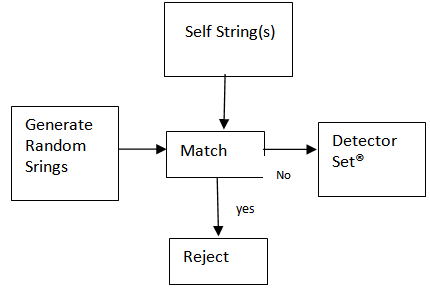 | Figure 1. Generation of Valid Detector Set (Censoring) (culled from[7]) |
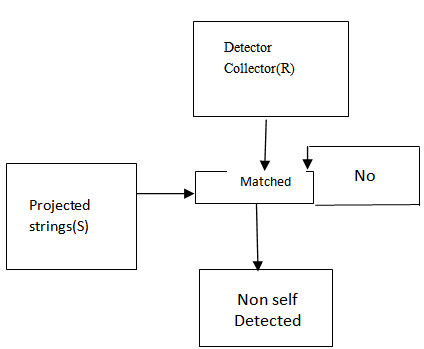 | Figure 2. The monitoring stage |
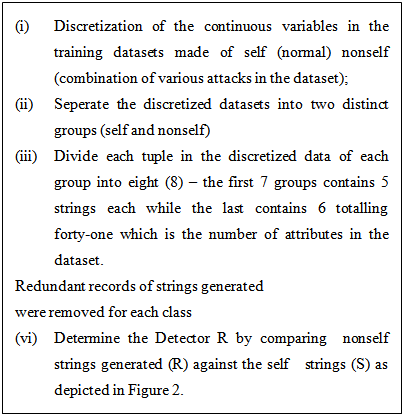 | Figure 3.1a. The Training Phase for[7] approach |
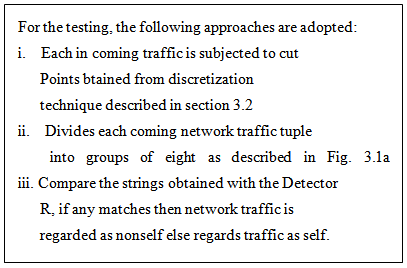 | Figure 3.1b. The testing algorithm |
7. The Proposed Model
- Our proposed model was a modified version of[7], which exclude generation of strings into groups which are computationally intensive. Rather our proposed method depends majorly on frequency distribution of attribute values with regards to the class group to generate nonself signature as spelt out in[18]. Examples of intrusions in Table 2 are used in illustating the working principles of the method.
|
|
8. Experimental Setup and Results
- The feasibility of this approach was demonstrated on the KDD ‘99 cup intrusion detection benchmark dataset earlier discussed. A total of 310,782 records were used for the experiment out of which 186,472 records randomly selected form the training dataset constituting 60.06% of the entire records used for experimental purpose; while the remaining 124,312 (39.94%) records carefully selected in the test dataset made up of all the attack types present.All the attack types earlier mentioned are simply grouped as nonself for the purpose of this work while category normal is simply renamed self. Preprocessing is grouped into three steps. In the first step, categorical features like protocol_type (3 different symbols tcp, udp,icmp), Service (66 different symbols), and flag (11 different symbols) were mapped to integer values ranging from 1 to N where N is the total number of symbol variation in each feature. In the second step, continuous-value attributes like duration, src_bytes, dst_bytes are standardized based on entropy earlier discussed. Appendix 1 shows the cutoff points of entropy on continuous attributes and the mapping obtained on the discretized dataset.After preprocessing in our approach, instances of duplicated records were removed from the training dataset. A total of 4264 records set made up of 3188 self and 1076 nonself were actually used for training and in obtaining the signature patterns of nonself. While for the Stephanie approach, the entire dataset was used.
8.1. Result Discussions
- Nonself signature patterns are obtained based on comparison of features in each network connection with the class label self with that of nonself. Results are presented in terms of variation(s) per attribute that achieved good levels of discrimination of self from nonself. This clearly distinguished a particular class label in the training data set. This can easily be achieved by generating the frequency of each variation per attribute against each class – self and nonself. Table 5 shows the signature pattern of non self obtained from the training dataset and a total of 12 attributes out of 41 presented for training are chosen.
|
 wherea. True Positives (TP), the number of self correctly classified as selfa. True Negatives (TN), the number of nonself correctly classified as nonselfb. False Positives (FP), the number of self falsely classified as nonselfc. False Negative (FN), the number of nonself falsely classified as self
wherea. True Positives (TP), the number of self correctly classified as selfa. True Negatives (TN), the number of nonself correctly classified as nonselfb. False Positives (FP), the number of self falsely classified as nonselfc. False Negative (FN), the number of nonself falsely classified as self
|
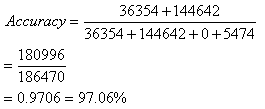
|

|

 | Figure 4. Attribute 4 variation dependency of self and nonself |
 | Figure 5. Attribute 5 variation dependency of self and nonself |
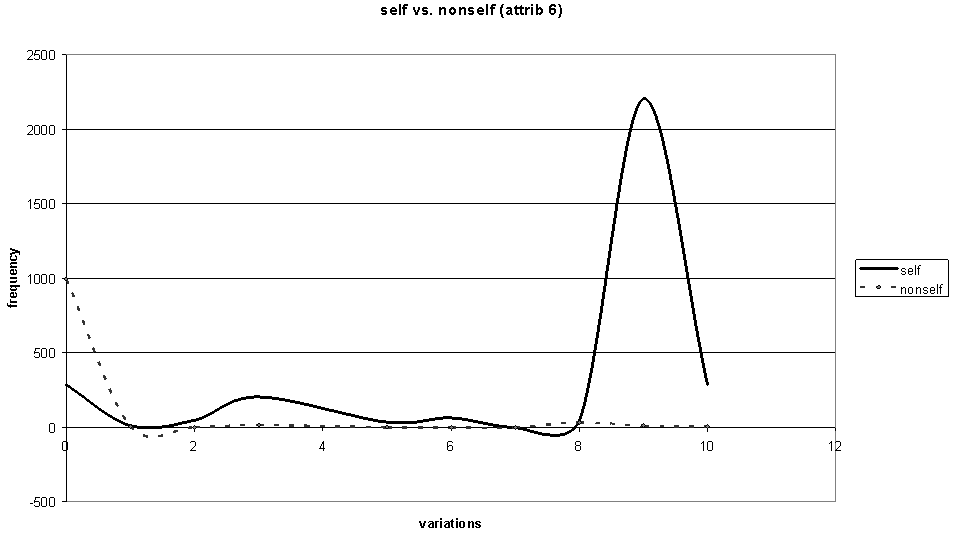 | Figure 6. Attribute 6 variation dependency of self and nonself |
|
 [7] approach is computational intensive during testing which does not make it appropriate for practical use because it has to compare the newly generated eights strings with the six hundred and one earlier generated Detector-R in its repertoire. The best matching that could be obtained is 1 while in a worst case it has to carry out exhaustive comparison of 4808 matches. The probabilistic approach of this technique was not evaluated as mathematical analysis shows that it is more computationally expensive. The mathematical analysis is computed thus:Assuming, there are 3 strings defined over the five alphabet (A,B,C,D,E) match at three contiguous locations. The number of three contiguous strings that could be obtained in a group of five alphabets = (number of strings in a group) – (number of contiguous strings) + 1 = 5-3+1 = 3Hence number of exhaustive matching for a group = DetectorR * number of contiguos * 3 = 601 * 3 * 3 = 5,409.Hence, for the eights groups that make up a network traffic in this case = 601 * 5409 = 3 250, 809. Our proposed model is less computational intensive, simpler and more effective in terms of computational accuracy.
[7] approach is computational intensive during testing which does not make it appropriate for practical use because it has to compare the newly generated eights strings with the six hundred and one earlier generated Detector-R in its repertoire. The best matching that could be obtained is 1 while in a worst case it has to carry out exhaustive comparison of 4808 matches. The probabilistic approach of this technique was not evaluated as mathematical analysis shows that it is more computationally expensive. The mathematical analysis is computed thus:Assuming, there are 3 strings defined over the five alphabet (A,B,C,D,E) match at three contiguous locations. The number of three contiguous strings that could be obtained in a group of five alphabets = (number of strings in a group) – (number of contiguous strings) + 1 = 5-3+1 = 3Hence number of exhaustive matching for a group = DetectorR * number of contiguos * 3 = 601 * 3 * 3 = 5,409.Hence, for the eights groups that make up a network traffic in this case = 601 * 5409 = 3 250, 809. Our proposed model is less computational intensive, simpler and more effective in terms of computational accuracy.9. Conclusions
- The need for effective and efficient security on our system cannot be over-emphasized. This position is strengthened by the degree of human dependency on computer systems and the electronic superhighway (Internet) which grows in size and complexity on daily basis for business transactions, source of information or research. This technique based on immune system for discriminating network traffic was implemented on Intel Pentium(R) 4, CPU 2.66GHz, 512 MB RAM using C++ programming language. From the experiment, IMNST performances outweights that of Stephanie on both the training and testing sets as her accuracy stood at 97.06% and 88.06%, against 89.65% and 85.70% respectively. The immune algorithm proposed is easier in obtaining effective signature patterns for classifying network traffic. This method could as well be employed in obtaining virus signatures and in other classifying problems. The results of the developed tools are satisfactory though it can be improved upon. These tools will go a long way in alleviating the problems of security of data on computing systems.
Appendix 1: Cutoff Points Obtained on Continuous Features
- cut_point1[9] = {0.5,2,132.5,585,712,717.5,899.5,1100.5,4490.5,};cut_point5[25] = {0.5,3,5.5,9.00001,18,19.5,27.5,36.5,103,105,106,168,168.5,342,342.5,1031, 1033.5,1480,1480.5,1563,2438,16050,49080, 132704,882177,};cut_point6[10] = {0.5,2.5,35.5,105,106,114.5,142.5,144,148.5,15235,};cut_point8[1] = {0.5,};cut_point9[0] = {};cut_point10[2] = {0.5,2,};cut_point11[1] = {2.5,};cut_point13[1] = {0.5,};cut_point14[1] = {0.5,};cut_point15[1] = {0.5,};cut_point16[1] = {0.5,};cut_point17[2] = {0.5,1.5,};cut_point18[1] = {0.5,};cut_point19[2] = {0.5,1.5,};cut_point20[0] = {};cut_point23[35] = {0.5,2.5,3.5,8.50001,9.50001,21.5,26.5,34.5,37.5,38.5,39.5,41.5,42.5,43.5,44.5,45.5,46.5,47.5,48.5,53.5,54.5,66.5001,82.5001,85.5001,105.5,150.5,160.5,198.5,208.5,300.5,408.5,413.5,484.5,485.5,509.5,};cut_point24[25] = {0.5,1.5,3.5,5.5,8.50001,9.50001,13.5,16.5,18.5,19.5,20.5,25.5,28.5,40.5,54.5,61.5,65.5001, 84.5001,102.5,112.5,153.5, 155.5,162.5,206.5,419,};cut_point25[18] = {0.00499916,0.0149975,0.0249977,0.0349961,0.0449944,0.0549965,0.0649949,0.0749894,0.0849915,0.0949937,0.11499, 0.144989,0.154984,0.164978,0.284973,0.954957,0.974976,0.994996,};cut_point26[7] = {0.00499916,0.0149975,0.0249977,0.0749894,0.149994,0.254975,0.974976,};cut_point27[3] = {0.0499955,0.494995,0.994996,};cut_point28[2] = {0.0249977,0.989991,};cut_point29[6] = {0.0349961,0.204987,0.219986,0.514954,0.909913,1,};cut_point30[11] = {0.00499916,0.0349961,0.104988,0.119995,0.144989,0.164978,0.204987,0.354981,0.464966,0.684937,1,};cut_point31[6] = {0.00499916,0.0149975,0.0249977,0.669922,0.709961,1,};cut_point32[6] = {0.5,1.5,7.50001,23,218,255,};cut_point33[13] = {0.5,1.5,2.5,6.5,16.5,20.5,101,101.5,251,251.5,252.5,253.5,254.5,};cut_point34[0] = {};cut_point35[18] = {0.00499916,0.0149975,0.0249977,0.0349961,0.0449944,0.0549965,0.0649949,0.0749894, 0.0849915,0.0949937,0.11499, 0.144989,0.154984,0.164978,0.284973,0.954957,0.974976,0.994996,};cut_point36[9] = {0.00499916,0.0149975,0.0549965,0.279968,0.294983,0.594971,0.964966,0.984986, 0.994996,};cut_point37[3] = {0.00499916,0.504944,0.634949,};cut_point38[7] = {0.00499916,0.0149975,0.0249977,0.0349961,0.0449944,0.0949937,0.994996,};cut_point40[15] = {0.00499916,0.0149975,0.0349961,0.0849915,0.124985, 0.164978, 0.414978,0.464966, 0.704957,0.799927,0.814942, 0.864991,0.884888,0.974976,0.984986,};cut_point41[12] = {0.00499916,0.0249977,0.0449944,0.0549965,0.0849915,0.11499,0.124985,0.454956, 0.709961,0.749939,0.824952,0.939942,};
References
| [1] | G. Meade, Department of Defense Trusted Computer System Evaluation Criteria, National Computer Security Service Centre, 1985. csfc.nist.gov/publications/history/dod85.pdf accessed February 2013 |
| [2] | S. Garfinkel, G. Spafford. Practical UNIX and Internet Security, 2nd Edition. O’Reilly and Associates, Inc. 1996 |
| [3] | C. Janeway, P. Traves, Immunobilogy, The Immune System in Health and Disease, 2nd Edition, Garland Science, New York, 1996 |
| [4] | C. Rui, T. Ying, A Virus Detection System Based on Artificial Immune System, International Conference on Computational Intelligence and Security, China. www.cii.pku.edu.cn/publication, 2009. |
| [5] | N. Liu, D. Wang, X. Huang, S. Liu, K. Zhao, Network Security Situation Awareness\Technology based on Artificial Immunity System. International Forum on Information Technology and Applications, 2009. |
| [6] | C.A. Janeway, P. Travers, M. Walport, M.J. Shilomchik, Immunology: The Immune System in Heath and desease, 5th Edition, New York: Garland, 2001. |
| [7] | F. Stephanie, S.P. Alan, A. Lawrence, C. Rajesh, Self-Nonself Discrimination in a Computer. Proc of IEEE Symposium on Research in Security and Privacy. Oakland: IEEE Press, 1994. pp. 202 - 212. |
| [8] | S.A. Hofmey, An Immunological Model of Distributed Detection and its Application to Computer Security, PhD Dissertation, University of New Mexico, 1999. |
| [9] | S. Forrest, T.A. Longstaff, "A Sense of Self for Unix processes", Proceedings of IEEE Symposium on Computer Security and Privacy, Los Alamos, CA, 1996, pp.120-128. |
| [10] | S. Bellovin, Defending against sequence number attacks internet engineering task force, May RFC 1948. number attacks internet engineering task force, May, RFC 1948, 1996 |
| [11] | L. Wenke, A data Mining Framework for Constructing Features and Models for Intrusion Detection Systems. PhD dissertation, Columbia University, USAhttp://www.cc.gatech.edu/~wenke, 1999. |
| [12] | S. Northcutt, J. Novak, Network Intrusion Detection: An Analyst’s Handbook, Second Edition, New Riders Publishers, USA, 2001. |
| [13] | S. Kumar, Classification and Detection of Computer Intrusions. PhD Dissertation, Department of Computer Science, Purdue University, 1995. |
| [14] | H. Debar, What is behavior based intrusion detection? IBM Zurich Research Laboratory, www.sans.org/privacy.php, 2003 |
| [15] | S. Axelsson, Intrusion Detection Systems: A survey and Taxonomy, Department of Computer Engineering, Chalmers University of Technology, Goteborg, Sweden. Technical Report TR-99-15,2000. |
| [16] | M. V. Mahoney, A machine Learning Approach to Detecting Attacks by Identifying Anomalies in Network Traffic, College of Engineering at Florida Institute of Technology, USA, PhD Dissertation, 2003. |
| [17] | KDD Cup 1999 Data. http://kdd.ics.uci.edu/databases/kddcup |
| [18] | A.O. Adetunmbi, S.O. Adeola, O.A. Daramola Relevance Features Selection for Intrusion Detection, Intelligent, Automation and System Engineering, Lecture Notes in Electrical Engineering, (Boston Springer), vol. 103, 2011, pp. 407 – 418. |
| [19] | A.O. Adetunmbi, S.O. Falaki, O.S. Adewale, B.K. Alese, Intrusion Detection based on rough Set and k-Nearest Neighbour, International Journal of Computing and ICT Research, vol. 2 No. 1, 2008, pp. 60-66. |
| [20] | H. Jiawei, K. Micheline, Data Mining: Concepts and Techniques, Second Edition, Elsevier Inc., 2006. |
 Abstract
Abstract Reference
Reference Full-Text PDF
Full-Text PDF Full-text HTML
Full-text HTML
